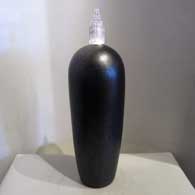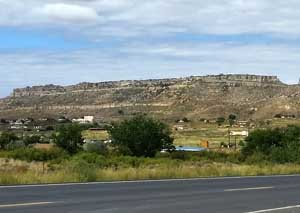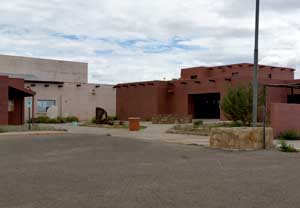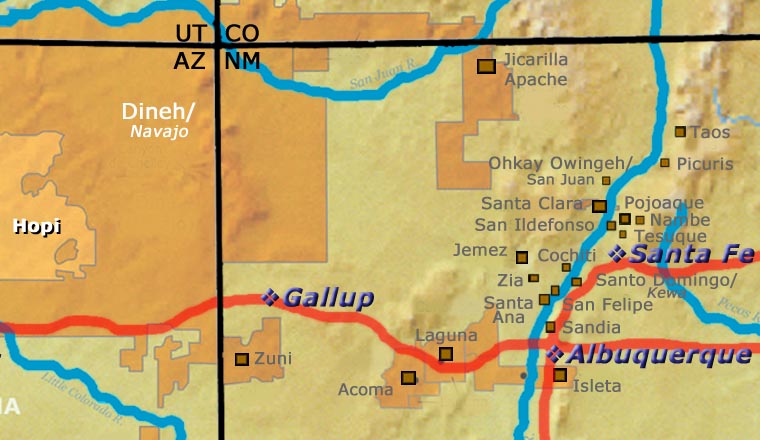
Preston Duwyenie
Hopi

"The pottery I make is a collaborative work between myself and the clay. It was through unsuccessful attempts in my earlier years to produce such a pot that Clay Woman taught me patience. She tells me to go slow and create one coil at a time and allow that to stand and stiffen before I add another. I received her teachings in that way and, in order to produce that piece of artwork, it has taken numerous years of trial and error. Being attuned to Clay Woman's teachings, listening to it and feeling it within my heart, that is how I learned patience."
Preston Duwyenie was born in 1951 in Hotevilla, on Hopi Third Mesa in northeastern Arizona. The Hopi people have lived on Third Mesa for centuries but Hotevilla is a new pueblo, founded in the early 1900s. Preston told us he grew up surrounded with beauty. "Everyone has an art. My mother was a basket weaver, my father a Katsina carver. You grow up learning how to make art." Lomaiquilvaa (Carried in Beauty) is his Hopi name, given to him after his godmother carried him home asleep late in the evening after his initiation ceremony. That name has evolved into Preston's hallmark.
Preston earned his Bachelor of Fine Arts at the Institute of American Indian Arts (IAIA), then he did some Master of Fine Arts coursework at the Colorado State University. In 1988, he returned to Santa Fe to take a position as Professor of Traditional Pottery and Jewelry at IAIA. It was there that Preston met his wife, Debra. In 1996 he retired from his academic position to focus on his art full time.
Since the late 1980s, Preston has used micaceous clays and sterling silver inlays in creating most of his contemporary pieces. In the Shifting Sands Series, he was inspired by the image of fine sand transformed by wind or water into a series of concentric subtle ripples. To him, the silver represents the precious lifeblood of water while the pattern etched around the inlay represents the clouds and the water they contain. This is a silent Hopi prayer for water to always be in the Earth so that we may exist.
As a traditional potter producing contemporary styles and designs, Preston has exhibited at the Heard Museum Guild Indian Arts Fair & Market in Phoenix, the Colorado Indian Market in Denver, Santa Fe Indian Market and the Eight Northern Indian Pueblos Arts & Crafts Show. Preston has earned countless awards in the traditional and contemporary pottery divisions, including two Best of Shows from the Colorado Indian Market and one Best of Show from the Heard.
Preston told us he finds his inspiration in Nature and most enjoys making pots with shoulders, then decorating them with shifting sands designs. In his words: "I love the profession I'm in... love doing it."
Some Exhibits that Featured Preston's Work
- What's New in New: Selections from the Carol Warren Collection. Lloyd Kiva New Gallery, Museum of Indian Arts and Culture. Santa Fe, New Mexico. June 3, 2018 - February 26, 2019. Note: exhibiting works include art by artists Tony Abeyta, Autumn Borts-Medlock, Preston Duwyenie, Tammy Garcia, Dan Namingha, Les Namingha, Jody Naranjo, Roxanne Swentzell, and Tito Naranjo
- Elegance from Earth: Hopi Pottery. Heard Museum. Phoenix, Arizona. March 24, 2012 - April 6, 2014
- Artistic Excellence: The Heard Museum Guild Indian Fair & Market Celebrates 60 Years. Heard Museum. Phoenix, Arizona. February 2, 2018 - August 31, 2018
- Choices and Change: American Indian Artists in the Southwest. Heard Museum North. Scottsdale, Arizona. June 30, 2007 - 2012
- Our Stories: American Indian Art and Culture in Arizona. Heard Museum West. Surprise, Arizona. July 26, 2006 - 2009
- Breaking the Surface: Carved Pottery Techniques and Designs. Heard Museum. Phoenix, Arizona. October 2004 - October 2005
- Jewels of the Southwest. Arizona Historical Society Museum. Tempe, Arizona. February 8, 2002 - April 28, 2002
- Remembering Our Indian School Days: The Boarding School Experience 1879 - Present. Heard Museum. Phoenix, Arizona. November 2000 - 2005
- Hopi Market Place. Museum of Northern Arizona. Flagstaff, Arizona. July 4-5, 1998
- Red Earth Fine Arts Festival Competition. Myriad Plaza. Oklahoma City, Oklahoma. June 1993
- The City of Phoenix Native American Art Collection. Phoenix City Hall. Phoenix, Arizona. 1993
- Celebrate the Spirit: Contemporary Native American Art. Mathes Cultural Center. Felicita Foundation for the Arts. Escondido, California. October 21, 1985 - November 30, 1985
Some of the Awards Won by Preston
- 2023 Santa Fe Indian Market, Classification II-D, Category 801 - Sgraffito, any form, Second Place, a collaboration with his wife, Debra
- 2023, Santa Fe Indian Market, Classification II-D, Category 806 - With added elements (like beads, feathers, stones, etc), any form, First Place, a collaboration with his wife, Debra
- 2020 Heard Museum Guild Indian Arts Fair & Market: Classification II - Pottery: Honorable Mention for Classification II. Awarded for collaborative artwork with Debra Duwyenie: "Turtles"
- 2019 Santa Fe Indian Market, Classification II - Pottery, Division D - Contemporary pottery, any form or design, using Native materials with or without added decorative elements, traditional firing techniques, Category 801 - Sgraffitto, any form: First Place shared with Debra Duwyenie
- 2019 Santa Fe Indian Market, Classification II - Pottery, Division D - Contemporary pottery, any form or design, using Native materials with or without added decorative elements, traditional firing techniques, Category 803 - Unpainted, any form: First Place
- 2019 Heard Museum Guild Indian Arts Fair & Market, Classification II - Pottery, Division E - Any design or form with native materials, kiln fired pottery: First Place. Awarded for artwork: "Twin Clouds"
- 2019 Heard Museum Guild Indian Arts Fair & Market: Judge's Award - Joe Baker. Awarded for artwork: "Shards"
- 2018 Santa Fe Indian Market, Classification II - Pottery, Division D, Contemporary Pottery, Any Form or Design, Using Native Materials with or without Added Decorative Elements, Traditional Firing Techniques, Category 806 - With added elements (like beads, feathers, stones, etc.), any form: First Place
- 2017 Santa Fe Indian Market, Classification II - Pottery, Division D - Contemporary Pottery, any form or design, using Native materials with or without added decorative elements, traditional firing techniques: Best of Division
- 2017 Santa Fe Indian Market, Classification II - Pottery, Division D - Contemporary Pottery, any form or design, using Native materials with or without added decorative elements, traditional firing techniques, Category 806 - With added elements (like beads, feathers, stones, etc), any form: First Place
- 2017 Heard Museum Guild Indian Arts Fair & Market, Classification II Pottery, Division G - Pottery miniatures not to exceed three (3) inches at its greatest dimension: Second Place. Awarded for collaborative artwork with Debra Duwyenie: "Turtles and Fish"
- 2016 Heard Museum Guild Indian Arts Fair & Market, Classification II - Pottery, Division C - Traditional - native clay, hand built, carved: Second Place collaboration with Debra Duwyenie
- 2015 Heard Museum Guild Indian Arts Fair & Market, Classification II - Pottery, Division E - Non-traditional design or form with native materials: Second Place
- 2014 Heard Museum Guild Indian Arts Fair & Market, Classification II - Pottery, Division G - Pottery miniatures, not to exceed 3 inches at its greatest dimension: First Place collaboration with Debra Duwyenie
- 2011 Heard Museum Guild Indian Arts Fair & Market, Classification II - Pottery, Division G - Miniatures: First Place with Debra Duwyenie
- 2010 Heard Museum Guild Indian Arts Fair & Market, Classification II - Pottery, Division E - Non-traditional design or form with native materials: First Place
- 2009 Heard Museum Guild Indian Fair & Market, Classification II - Pottery, Division G - Pottery Miniatures not to exceed 3" at its greatest dimension: First Place collaboration with Debra Duwyenie
- 2000 Santa Fe Indian Market, Classification II - Pottery, Division A - Traditional Unpainted Pottery, Category 804 - Taos, Picuris and Similar styles: Second Place
- 2000 Santa Fe Indian Market, Classification II - Pottery, Division H - Non-traditional pottery, Category 1507 - Bowls, unpainted other than stoneware: Third Place
- 1999 Santa Fe Indian Market, Classification II - Pottery, Division H - Non-traditional, Category 1507 - Bowls: First Place
- 1999 Heard Museum Guild Indian Arts Fair & Market, Classification VII - Pottery, Division D - Non-traditional/wheel thrown/glazed/commercial clay: Best of Division
- 1998 Hopi Market Place, Pottery Division, Plainware - Contemporary, non-traditional: First Place. Museum of Northern Arizona. Flagstaff, Arizona
- 1997 Santa Fe Indian Market: Challenge Award in Non-traditional Pottery
- 1997 Santa Fe Indian Market, Classification II - Pottery, Division A - Traditional unpainted pottery, Category 804 - Taos, Picuris & similar styles: First Place
- 1997 Santa Fe Indian Market, Classification II - Pottery, Division H - Non-traditional any forms using non-traditional materials or techniques, Category 1507 - Bowls: First Place
- 1997 Heard Museum Guild Indian Arts Fair & Market, Classification VII - Pottery: Best of Classification. Awarded for painting: "Shifting Sands - Phase Four"
- 1997 Heard Museum Guild Indian Arts Fair & Market, Classification VII - Pottery: Best of Classification, Division B - Traditional/Native Clay/Hand Built/Unpainted: Best of Division. Awarded for painting: "Shifting Sands - Phase Four"
- 1997 Heard Museum Guild Indian Arts Fair & Market. Judge's Choice Award - Dennis Lyon. Awarded for painting: "Shifting Sands - Phase Four"
- 1997 Heard Museum Guild Indian Arts Fair & Market. Judge's Choice Award - Georgia Loloma. Awarded for painting: "Shifting Sands - Phase Four"
- 1996 Santa Fe Indian Market, Classification II - Pottery, Division A - Traditional unpainted pottery, Category 805 - Other plain ware: First Place
- 1996 Santa Fe Indian Market, Classification II - Pottery, Division H - Non-traditional any forms, using non-traditional materials or techniques, Category 1507 - Bowls, unpainted, other than stoneware: First Place
- 1996 Heard Museum Guild Indian Arts Fair & Market: Best of Show. Awarded for artwork: "Shifting Sands". Shared Best of Show honors with Barbara Teller Ornelas
- 1996 Heard Museum Guild Indian Arts Fair & Market, Classification VII - Pottery: Best of Classification. Awarded for artwork: "Shifting Sands"
- 1996 Heard Museum Guild Indian Arts Fair & Market, Classification VII - Pottery, Division B - Wheel-thrown, glazed, non-native traditional firing: Best of Division. Awarded for artwork: "Shifting Sands"
- 1994 Santa Fe Indian Market, Classification II - Pottery, Division B - Traditional pottery, undecorated, Category 901 - jars up to 9" tall: First Place
- 1993 Santa Fe Indian Market, Classification I - Jewelry, Division G - Metal items with or without stones, Category 701 - Boxes, canteens & closed containers: Third Place
- 1993 Santa Fe Indian Market, Classification II - Pottery, Division J - Non-traditional, any forms using non-traditional materials or techniques, Category 1604 - Bowls: First Place
- 1993 Santa Fe Indian Market, Classification II - Pottery, Division J - Non-traditional, any forms using non-traditional materials or techniques, Category 1612 - Miscellaneous: Second Place
- 1993 Red Earth Fine Arts Festival and Competition, Pottery Division - Non-traditional pottery: First Place. Myriad Plaza. Oklahoma City, Oklahoma
- 1992 Santa Fe Indian Market: Most Creative Design in any Classification
- 1992 Santa Fe Indian Market, Classification I - Jewelry, Division C - Non-traditional metal jewelry with or without stones, Category 306 - Matched sets: Third Place
- 1992 Santa Fe Indian Market, Classification I - Jewelry, Division G - Metal items with or without stones, Category 703 - Bowls, jars, plates & ashtrays: Second Place
- 1992 Santa Fe Indian Market, Classification II - Pottery, Division H - Non-traditional pottery, new forms using traditional materials and techniques, Category 1504 - Bowls: Second Place
- 1992: 20th Annual Artist and Craftsman Show, Division - Pottery: Best of Show. Eight Northern Indian Pueblos Council. San Juan Pueblo, New Mexico
- 20th Annual Artist and Craftsman Show, Division - Pottery, Division - Jewelry, Up and Coming Artist in Jewelry: First Place. Eight Northern Indian Pueblos Council. San Juan Pueblo, New Mexico. July 1992.
- 1992 Heard Museum Guild Indian Arts Fair & Market, Classification VII - Pottery, Non-traditional methods: Honorable Mention
- 1991 Santa Fe Indian Market, Classification I - Jewelry, Division C- Non-traditional metal jewelry with or without stones, Category 308 - Handmade items: Second Place
- 1991 Santa Fe Indian Market, Classification II - Pottery, Division D - Traditional pottery, carved, Category 1103 - Bowls (up to 8 inches in diameter): Second Place
- 1991 Santa Fe Indian Market, Classification II - Pottery, Division H - Non-traditional pottery, new forms using traditional materials and technology: Best of Division
- 1991 Santa Fe Indian Market, Classification II - Pottery, Division H - Non-traditional pottery, new forms using traditional materials and techniques, Category 1503 - Jars: First Place
- 1991 Santa Fe Indian Market, Classification II - Pottery, Division J- Non-traditional, any forms using non-traditional materials or techniques, Category 1611 - Miscellaneous: Second Place
- 1991 Santa Fe Indian Market, Classification V - Weaving and Baskets, Division B - Non-traditional weaving, textiles, attire and miscellaneous items, Category 2604 - Purses, pillows, wall hangings: First Place
- 1989 Santa Fe Indian Market, Classification II - Pottery, Division G - Traditional pottery, Category 1209 - Other bowl forms: First Place
- 1986 Santa Fe Indian Market, Classification II - Pottery, Division H - Non-traditional pottery, new forms and innovations, Category 1303 - Jars and vases unpainted: Second Place
- 1986 Santa Fe Indian Market, Classification III - Paintings, drawings and prints (hand pulled), Division C - Painting, any style, Category 1704 - Drawings: First Place
- 1986 Colorado Winter Indian Market, Rocky Mountain Rendezvous of Tribal Nations, Contemporary Indian Art: Best of Show. Boulder, Colorado
- 1985 Santa Fe Indian Market, Classification II - Pottery: Best of Classification
- 1985 Santa Fe Indian Market, Classification II - Pottery, Division H - Non-traditional pottery: First Place
- 1985 Colorado Winter Indian Market, Rocky Mountain Rendezvous of Tribal Nations: Best of Show. Awarded for Pottery "Earth in Balance". Boulder, Colorado
- 1985 Colorado Winter Indian Market, Rocky Mountain Rendezvous of Tribal Nations, Sculpture Division - Mixed Media: First Place. Boulder, Colorado
- 1985 Colorado Winter Indian Market, Rocky Mountain Rendezvous of Tribal Nations, Pottery Division - Best of Division
- 1985 Colorado Winter Indian Market, Rocky Mountain Rendezvous of Tribal Nations, Pottery Division, Contemporary Carved Pottery: First Place. Boulder, Colorado
- 1980 Gallup Inter-Tribal Ceremonial, Sculpture: Third Place. Red Rock State Park. Gallup, New Mexico
100 West San Francisco Street, Santa Fe, New Mexico 87501
(505) 986-1234 - www.andreafisherpottery.com - All Rights Reserved

Hopi

Tewa Village and First Mesa
The Hopi people live in villages on or around three mesas in northeastern Arizona. Some of these villages have been continuously occupied since the 12th century. The Hopi are not so much a "people" as a collection of clans that came together in times of drought and other misfortune. The Hopi mesas have long been seen as sanctuaries. As a result, the landscape around First Mesa is littered with the remains of villages once founded by people belonging to similar clans but speaking many different languages.
As a result, the Hopi pottery tradition is also quite varied with roots traced as far away as vitrified ceramics found in the environs of Valdivia, Ecuador, and produced between 1200 and 1500 BCE. Archaeologists excavating in the abandoned pueblos around First Mesa also found sherds of pottery styles and painted designs found in the Rio Salado region and among the ancient Sinagua settlements in the Wupatki, Tuzigoot, Walnut Canyon and Homol'ovi areas (all abandoned between about 950 and 1250 CE).
The area around Jeddito was occupied by Towa-speaking people beginning in the late 1200s. The Jeddito area is where Jeddito yellow is found, the clay that made the pottery of Sikyátki so spectacular. Beginning in the 1200s, Keres-speaking people arriving from the east began to build what became Awat'ovi, on Antelope Mesa between Jeddito and First Mesa. Sikyátki itself was also built by people from the east beginning in the early 1300s. At first Sikyátki was inhabited solely by the Kokop (Firewood) clan, then the Coyote clan came and grew to become the largest single clan in the village. Why the village was destroyed is shadowed in myth but Jesse Walter Fewkes (the first archaeologist to excavate in the area) felt the village was destroyed before the first Spanish visitor arrived in 1540. Oral history has it that Sikyátki and its people were completely wiped out but the clans that inhabited that village have somehow continued to exist. Modern dating techniques have set the destruction of Sikyátki around 1625.

The Hopi Cultural Center
The ruins at Awat'ovi (on Antelope Mesa, east of Walpi and south of Keams Canyon) have yielded potsherds in styles and with designs that were also prominent in the prehistoric village now known as Pottery Mound (in central New Mexico). Among the potsherds found at Pottery Mound are plain and decorated Hopi products, white clay products from the Acoma-Zuni area and red clay products from north-central New Mexico. Pottery Mound was abandoned about 100 years before the Spanish arrived in New Mexico in 1540. Also similar to Pottery Mound, Awat'ovi had several kivas painted with layers of wall murals, each painted on top of the whitewashed last.
It has been reported that many of the residents of Awat'ovi were Keres-speaking people from the Four Corners area and were not as resistant as other Hopis were to the Christianizing practices of the Spanish Franciscan monks when they came into the Hopi lands around 1609. As Awat'ovi was the only pueblo in the Hopi region where a Christian mission was built, most archaeologists attribute that to the reason why residents of Walpi and Old Oraibi destroyed the village and killed nearly all its residents in the winter of 1700-1701. However, at the time of that destruction, Awat'ovi was the largest and most populous pueblo in the Hopi mesas. It was also around 1690 that the people of Walpi were relocating from their old pueblo at the foot of First Mesa to their new location atop the southernmost finger of First Mesa, a move made for defensive reasons. This was after the Pueblo Revolt of 1680 and everyone was expecting the hated Spanish to return, with more soldiers and priests.
Southern Tewa warriors and their families began arriving in the area in 1696 and were steered to take up residence at the foot of First Mesa, along the only route to the mesa top (in that location, the Tewas would be the first people to encounter incoming Spanish military - the people of Walpi felt they would make a good first line of defense should the Spanish attempt to reconquer them). The Tewas were also good at repulsing Ute, Paiute and Navajo raiders. After they won a decisive battle with Ute raiders they were allowed to build Tewa Village (also known as Hano) at the gap between the rocks on the trail up First Mesa. Some of the Tewa women were potters and in the ages-old way, they slowly shared what they knew with Hopi potters, and vice versa. That cross-pollination went on for years, and not just with pottery. Cross-cultural marriages happened, too, and today the people are known as Hopi, Hopi-Tewa and Tewa, depending on their ancestry. And while Tewa Village is completely surrounded by the Hopi Reservation, many of the residents are fluent in Tewa, Hopi and English. Some are fluent in Spanish and Navajo, too. There is a tribal injunction against any Hopi speaking Tewa: they may understand what is being spoken in Tewa but they are not allowed to speak Tewa themselves.
During those same troubled times Towa-speaking people migrated into Hopi and Navajo territory (primarily in the Jeddito Wash area) to escape the violence of the Spanish reconquest. They established familial ties that are still in place today (which may explain why Jeddito Wash is a Navajo Reservation island surrounded by the Hopi Reservation).
The village of Sichomovi was founded in the 1600s by members of the Wild Mustard Clan, Roadrunner Clan and others who'd come to the area from east of Santa Fe (Pecos Pueblo and the pueblos of the Galisteo Basin) via Zuni. They seem to have stopped at Zuni for a few years and assimilated somewhat. When they moved on to Hopi, there were quite a few Zunis among them, that's why the people of Walpi (and some from Zuni) refer to Sichomovi as a Zuni pueblo.
They arrived at Hopi around 1600 CE and became known as the Asa clan. They had traveled from the Abiquiu area through Santo Domingo, Acoma, Laguna and Zuni, picking up and dropping off people, technology and social practices along the way. Some settled at Awat'ovi while others continued to Coyote Spring (under the gap at First Mesa). They built a new pueblo where Hano now stands (it was known as Hano back then, too). A few years later drought and disease caused them to relocate again.
The quality, styles and designs of Sikyátki had lived on in Awat'ovi pottery, although the potters of Awat'ovi were also enamored of using a white slip on top of the Jeddito clay base. The potters of Awat'ovi also introduced some new designs (the "Awat'ovi star" being one) but after the village was destroyed, very little of their knowledge and practice passed on. Hopi ceramics entered a virtual Dark Age for almost 200 years.
By the mid-1800s the Hopi pottery tradition had been almost completely abandoned, its utilitarian purposes being taken over by cheap enamelware brought in by Anglo traders. Hopi pottery production sputtered along until the late 1800s when one woman, Nampeyo of Hano, almost single-handedly revived it. Nampeyo lived in Tewa Village by First Mesa and was inspired by potsherds found among the nearby ruins of Sikyátki. Today credit is given to Nampeyo for fully reviving the Sikyátki style. She was so good that Jesse Walter Fewkes, the first archaeologist to formally excavate Sikyátki, was concerned that her creations would shortly become confused with those made hundreds of years previously.
Sikyátki pottery shapes are very distinctive: flattened jars with wide shoulders; low, open bowls decorated inside; seed jars with small openings and flat tops; painting methods of splattering and stippling and very distinctive designs. The Sikyátki style originally evolved when migrant Keres and Towa-speaking potters got together with migrant Water Clan potters from the Hohokam areas of southern Arizona and northern Mexico and they began working with clays found in the Jeddito area. Over the years other clans came to the area and made their own contributions to what we now know as "Sikyátki Polychrome." Accoding to Jesse Walter Fewkes, that merging of styles, techniques and designs created some of the finest ceramics ever produced in prehistoric North America.
Today's Hopi pottery tends to be a white, yellow, orange or buff colored background decorated with designs in red and black mineral paints. Painted designs sometimes fill the entire space, often with an asymmetrical and symmetrical design. Most of the symbology painted on Hopi pottery is themed with "bird elements:" eagle tails, feathers, bird wings and migration patterns. Many Hopi, Hopi-Tewa and Tewa potters are members of the Corn Clan and their annual religious cycle revolves around the seasons of corn. The vast majority of today's Hopi pottery shapes and the designs painted on them are obvious descendants of the work of Sikyátki and Awat'ovi potters.
100 West San Francisco Street, Santa Fe, New Mexico 87501
(505) 986-1234 - www.andreafisherpottery.com - All Rights Reserved



